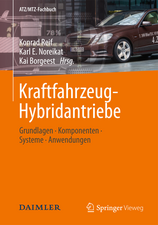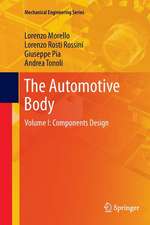The Motor Car: Past, Present and Future: Mechanical Engineering Series
Autor Giancarlo Genta, Lorenzo Morello, Francesco Cavallino, Luigi Filtrien Limba Engleză Hardback – 17 ian 2014
The first part describes how motor vehicles were invented and evolved into the present product in more than 100 years of development. The purpose is not only to supply an historical perspective, but also to introduce and discuss the many solutions that were applied (and could be applied again) to solve the same basic problems of vehicle engineering. This part also briefly describes the evolution of automotive technologies and market, including production and development processes.
The second part deals with the description and function analysis of all car subsystems, such as:
· vehicle body,
· chassis, including wheels, suspensions, brakes and steering mechanisms,
· diesel and gasoline engines,
· electric motors, batteries, fuel cells, hybrid propulsion systems,
· driveline, including manual and automatic gearboxes.
This part addresses also many non-technical issues that influence vehicle design and production, such as social and economic impact of vehicles, market, regulations, particularly on pollution and safety.
In spite of the difficulty in forecasting the paths that will be taken by automotive technology, the third part tries to open a window on the future. It is not meant to make predictions that are likely to be wrong, but to discuss the trends of automotive research and innovation and to see the possible paths that may be taken to solve the many problems that are at present open or we can expect for the future.
The book is completed by two appendices about the contribution of computers in designing cars, particularly the car body and outliningfundamentals of vehicle mechanics, including aerodynamics, longitudinal (acceleration and braking) and transversal (path control) motion.
| Toate formatele și edițiile | Preț | Express |
|---|---|---|
| Paperback (1) | 659.53 lei 6-8 săpt. | |
| SPRINGER NETHERLANDS – 17 sep 2016 | 659.53 lei 6-8 săpt. | |
| Hardback (1) | 666.06 lei 6-8 săpt. | |
| SPRINGER NETHERLANDS – 17 ian 2014 | 666.06 lei 6-8 săpt. |
Din seria Mechanical Engineering Series
-
 Preț: 391.84 lei
Preț: 391.84 lei - 18%
 Preț: 1110.72 lei
Preț: 1110.72 lei - 15%
 Preț: 593.73 lei
Preț: 593.73 lei - 18%
 Preț: 944.99 lei
Preț: 944.99 lei - 15%
 Preț: 653.14 lei
Preț: 653.14 lei - 17%
 Preț: 363.12 lei
Preț: 363.12 lei - 18%
 Preț: 1239.05 lei
Preț: 1239.05 lei - 15%
 Preț: 640.06 lei
Preț: 640.06 lei - 18%
 Preț: 1129.65 lei
Preț: 1129.65 lei - 15%
 Preț: 522.24 lei
Preț: 522.24 lei - 15%
 Preț: 654.77 lei
Preț: 654.77 lei - 15%
 Preț: 643.34 lei
Preț: 643.34 lei - 15%
 Preț: 611.40 lei
Preț: 611.40 lei - 18%
 Preț: 765.96 lei
Preț: 765.96 lei - 20%
 Preț: 631.70 lei
Preț: 631.70 lei - 18%
 Preț: 1009.22 lei
Preț: 1009.22 lei -
 Preț: 418.34 lei
Preț: 418.34 lei - 15%
 Preț: 640.71 lei
Preț: 640.71 lei -
 Preț: 403.53 lei
Preț: 403.53 lei - 18%
 Preț: 813.97 lei
Preț: 813.97 lei - 18%
 Preț: 1386.48 lei
Preț: 1386.48 lei - 18%
 Preț: 951.47 lei
Preț: 951.47 lei - 18%
 Preț: 833.09 lei
Preț: 833.09 lei - 18%
 Preț: 936.60 lei
Preț: 936.60 lei - 15%
 Preț: 644.49 lei
Preț: 644.49 lei - 18%
 Preț: 941.05 lei
Preț: 941.05 lei - 18%
 Preț: 1386.17 lei
Preț: 1386.17 lei -
 Preț: 399.67 lei
Preț: 399.67 lei - 18%
 Preț: 1389.44 lei
Preț: 1389.44 lei - 18%
 Preț: 790.46 lei
Preț: 790.46 lei - 18%
 Preț: 1388.22 lei
Preț: 1388.22 lei - 18%
 Preț: 1024.53 lei
Preț: 1024.53 lei - 15%
 Preț: 590.16 lei
Preț: 590.16 lei - 18%
 Preț: 1234.00 lei
Preț: 1234.00 lei - 18%
 Preț: 1386.62 lei
Preț: 1386.62 lei - 15%
 Preț: 543.85 lei
Preț: 543.85 lei -
 Preț: 391.61 lei
Preț: 391.61 lei - 18%
 Preț: 944.19 lei
Preț: 944.19 lei - 18%
 Preț: 736.16 lei
Preț: 736.16 lei - 18%
 Preț: 943.88 lei
Preț: 943.88 lei - 15%
 Preț: 693.21 lei
Preț: 693.21 lei - 18%
 Preț: 781.77 lei
Preț: 781.77 lei - 15%
 Preț: 639.08 lei
Preț: 639.08 lei - 23%
 Preț: 737.28 lei
Preț: 737.28 lei - 15%
 Preț: 641.53 lei
Preț: 641.53 lei -
 Preț: 401.42 lei
Preț: 401.42 lei
Preț: 666.06 lei
Preț vechi: 783.59 lei
-15% Nou
Puncte Express: 999
Preț estimativ în valută:
127.45€ • 133.43$ • 105.46£
127.45€ • 133.43$ • 105.46£
Carte tipărită la comandă
Livrare economică 05-19 aprilie
Preluare comenzi: 021 569.72.76
Specificații
ISBN-13: 9789400785519
ISBN-10: 9400785518
Pagini: 688
Ilustrații: XXIV, 662 p. 418 illus. in color.
Dimensiuni: 155 x 235 x 43 mm
Greutate: 1.13 kg
Ediția:2014
Editura: SPRINGER NETHERLANDS
Colecția Springer
Seria Mechanical Engineering Series
Locul publicării:Dordrecht, Netherlands
ISBN-10: 9400785518
Pagini: 688
Ilustrații: XXIV, 662 p. 418 illus. in color.
Dimensiuni: 155 x 235 x 43 mm
Greutate: 1.13 kg
Ediția:2014
Editura: SPRINGER NETHERLANDS
Colecția Springer
Seria Mechanical Engineering Series
Locul publicării:Dordrecht, Netherlands
Public țintă
ResearchCuprins
Economic figures.- Vehicle and parts manufacturers.- Impact on economy.- Product development and marketing.- Vehicle diffusion.- Regulations.- Type approval and production conformity.- Environmental protection.- Occupants and pedestrians safety.- Body.- Body in white.- Interiors.- Body systems.- Chassis.- Tire.- Suspension.- Steering system.- Braking system.- Powertrain mounts.- Transmission.- Powertrain.- ICE working cycles.- ICE design.- ICE ancillaries.- Manual gearboxes.- Automatic gearboxes.- Full electric powertrains.- Hybrid powertrains.- Production systems and materials and materials.- Steel mill.- Body presswork.- Body welding.- Body painting.- Iron and aluminum foundry.- Plastic materials.- Fuels and lubricants.- Body.- Separated body.- Unitized body.- Body systems.- Vehicle architecture.- Future developments.
Textul de pe ultima copertă
This book is an introduction to automotive engineering, to give freshmen ideas about this technology. The text is subdivided in parts that cover all facets of the automobile, including legal and economic aspects related to industry and products, product configuration and fabrication processes, historic evolution and future developments.
The first part describes how motor vehicles were invented and evolved into the present product in more than 100 years of development. The purpose is not only to supply an historical perspective, but also to introduce and discuss the many solutions that were applied (and could be applied again) to solve the same basic problems of vehicle engineering. This part also briefly describes the evolution of automotive technologies and market, including production and development processes.
The second part deals with the description and function analysis of all car subsystems, such as:
· vehicle body,
· chassis, including wheels, suspensions, brakes and steering mechanisms,
· diesel and gasoline engines,
· electric motors, batteries, fuel cells, hybrid propulsion systems,
· driveline, including manual and automatic gearboxes.
This part addresses also many non-technical issues that influence vehicle design and production, such as social and economic impact of vehicles, market, regulations, particularly on pollution and safety. In spite of the difficulty in forecasting the paths that will be taken by automotive technology, the third part tries to open a window on the future. It is not meant to make predictions that are likely to be wrong, but to discuss the trends of automotive research and innovation and to see the possible paths that may be taken to solve the many problems that are at present open or we can expect for the future.
The book is completed by two appendices about the contribution of computers in designing cars, particularly the car body, and outlining fundamentals of vehicle mechanics, including aerodynamics, longitudinal (acceleration and braking) and transversal (path control) motion.
The first part describes how motor vehicles were invented and evolved into the present product in more than 100 years of development. The purpose is not only to supply an historical perspective, but also to introduce and discuss the many solutions that were applied (and could be applied again) to solve the same basic problems of vehicle engineering. This part also briefly describes the evolution of automotive technologies and market, including production and development processes.
The second part deals with the description and function analysis of all car subsystems, such as:
· vehicle body,
· chassis, including wheels, suspensions, brakes and steering mechanisms,
· diesel and gasoline engines,
· electric motors, batteries, fuel cells, hybrid propulsion systems,
· driveline, including manual and automatic gearboxes.
This part addresses also many non-technical issues that influence vehicle design and production, such as social and economic impact of vehicles, market, regulations, particularly on pollution and safety. In spite of the difficulty in forecasting the paths that will be taken by automotive technology, the third part tries to open a window on the future. It is not meant to make predictions that are likely to be wrong, but to discuss the trends of automotive research and innovation and to see the possible paths that may be taken to solve the many problems that are at present open or we can expect for the future.
The book is completed by two appendices about the contribution of computers in designing cars, particularly the car body, and outlining fundamentals of vehicle mechanics, including aerodynamics, longitudinal (acceleration and braking) and transversal (path control) motion.
Caracteristici
Covers all aspects of present automotive technology Describes the historical evolution of automotive technology Supplies tools to analyze vehicle performance Includes supplementary material: sn.pub/extras




















